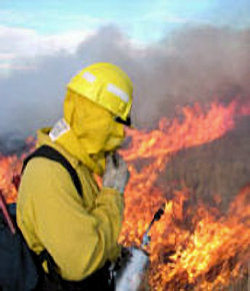The Criteria Pollutants
The Clean Air Act requires the Environmental Protection Agency (EPA) to set National Ambient Air Quality Standards (NAAQS) for six common air pollutants.
Criteria Air Pollutants include:

1. Particulate Matter (PM): A complex mixture of tiny solid particles and liquid droplets suspended in the air. When inhaled, these particles can reach deep into the lungs and even enter the bloodstream.
- Examples: Dust, dirt, soot, smoke, ash, pollen.
- Sources: Wildfires, construction activities, unpaved roads, power plants, and vehicle exhaust.
- Health effects: Asthma attacks, lung disease, heart problems, premature death in sensitive groups.
- Environmental impacts: Reduces visibility (haze), damages crops, soils, and water systems.
2. Ground-Level Ozone: A harmful gas formed when sunlight reacts with pollutants such as nitrogen oxides (NOx) and volatile organic compounds (VOCs). Unlike the protective ozone layer high in the atmosphere, ground-level ozone is dangerous to breathe.
- Examples: Main component of urban smog.
- Sources: Vehicle emissions, power plants, industrial facilities, and chemical solvents exposed to sunlight.
- Health effects: Coughing, throat irritation, worsened asthma, reduced lung function, breathing difficulties.
- Environmental impacts: Damages crops, forests, and sensitive ecosystems.
3. Carbon Monoxide (CO): A colorless, odorless, tasteless gas created by the incomplete burning of fossil fuels. It prevents oxygen from being carried through the body when inhaled.
- Examples: Vehicle exhaust, faulty heating systems, indoor generators.
- Sources: Cars, trucks, small engines, gas stoves, and furnaces.
- Health effects: Headaches, dizziness, nausea, impaired vision, cardiovascular stress, death in high concentrations.
- Environmental impacts: Contributes to ground-level ozone formation.
4. Sulfur Oxides (SOx): Gases produced when fuels containing sulfur are burned. Sulfur dioxide (SO2) is the most common form and a major contributor to acid rain.
- Examples: Sulfur dioxide from coal-fired power plants.
- Sources: Burning coal and oil, industrial facilities, metal smelters, ships, and locomotives.
- Health effects: Irritates airways, triggers asthma, worsens lung and heart disease.
- Environmental impacts: Causes acid rain, damages crops, soils, lakes, and building materials.
5. Nitrogen Oxides (NOx): Highly reactive gases produced from combustion. They play a major role in the formation of ground-level ozone and smog.
- Examples: Nitric oxide (NO), nitrogen dioxide (NO2).
- Sources: Cars, trucks, power plants, industrial boilers, and agricultural activities.
- Health effects: Irritates lungs, worsens asthma, increases risk of respiratory infections.
- Environmental impacts: Contributes to smog and acid rain, harms ecosystems, reduces visibility.
6. Lead: A toxic metal once widely used in gasoline, paint, and plumbing. Though greatly reduced in the U.S., lead is still released into the air from some industries.
- Examples: Lead-acid batteries, old paint, contaminated soil.
- Sources: Industrial processes, metal smelters, battery recycling, previously from leaded gasoline.
- Health effects: Affects brain and nervous system, slows growth and development, especially harmful to children.
- Environmental impacts: Contaminates soil and water, harms wildlife and plants.
Knowledge Check Choose the best answer for the question.
2-7. Which of the following common air pollutants can cause harmful health effects by reducing oxygen delivery to the body's organs and tissues?
You forgot to answer the question!
